#Regioshuttle
Explore tagged Tumblr posts
Text

650 535 bei Friedrichswalde am 02.04.2022
#650 535#NEB VT 003#Br650#Br 650#Regioshuttle#eisenbahn#bahnhof#bahn#berlin#triebwagen#brandenburg#dieseltriebwagen#Barnim#Friedrichswalde#Niederbarnimer Eisenbahngesellschaft#NEBB#Niederbarnimer Eisenbahn#NEB
13 notes
·
View notes
Video
IMG_6690 por Gerhard Barth Por Flickr: RegioShuttle als Ringzug kurz Immendingen/Donau
6 notes
·
View notes
Text
Something that really fascinates me is the concept of “American words”. You know, words that US Americans associate with the USA, and the pandering way in which this used. I’m specifically looking at this in the context of trains.
For the longest time, with very few exceptions, the rail industry has used numeric or alphanumeric codes to refer to vehicles. Some trains got nicknames, but for the most part, you talk about SD40-2 and GG1 and GP9 and Re 4/4 II and 141R and F40PH and LNER A4 and class 95 and V100 (east) and DD 16 and BB 15000 and what have you. Stuff that makes you sound crazy to any non-railfan, and that’s how we like it. None of these are made up, by the way, I have all of them in my model railroad collection (the 141R is new).
That’s because this is all a strictly business-to-business thing. Nobody buys a particular locomotive, car or train because of the great name or advertisement, they do it because they ran the numbers and a lot of negotiating.
Over the years, however, that shifted. The first major time (apart from a few one-off named trains) in the US was probably the General Electric P40, P42 and P32, collectively known as “Genesis”. That’s already a fairly “American” word: Explicitly biblical, which is less popular in Europe (let alone other parts of the world), and it sounds meaningful: Something something start, new beginning. The locomotive is the beginning of the train, anyway, so it’s not like it’s wrong.
In Europe, we’ve seen this in full force during the 90s and especially 2000s, together with a huge shift in how railroading worked at all. Before, it used to be that the rail industry of one country got together with the country’s main railroad, and designed one locomotive together, and everyone got to build at least parts of it. A lot of mergers and liberalisation of the rail market means that nowadays, the rail industry is organised as multinational corporations (I’d say four major ones at the moment, but I won’t say which ones so nobody gets angry at me for saying the wrong ones), and these design the trains in house and then try to sell them, with real marketing departments and such.
For example, in the 80s and early 90s, there was exactly one regional diesel train that was being built in Germany, the class 628. It was only built for Germany (mostly, a few ended up in Luxembourg), too. Other countries had very similar trains, notably the Netherlands and Austria, which were derived from the German design and built under license, but by their own local rail industry to their own standards.
On the other hand, by 2000, in the same market (but now low-floor for better accessibility and climatized), we had things like the class 642, 643, 646 and 648, and that’s not counting the weird ones (such as the shorter 640, 641 and 650) or the ones only sold to private companies. All of them did the same thing, but all of them were built by different companies (Siemens, Bombardier, Stadler and Alstom in order), and all of them were also exported, unchanged, to many other countries around the world. Even North America got a small set of each of these types.
And since there were many, it was decided that marketing was now in order. These trains no longer only had class numbers from the railroad that ordered them; instead they got names from their manufacturers. In those cases, Coradia LINT, TALENT, GTW and Desiro, and there were also RegioShuttle, RegioSprinter and Itino, and yes I am missing some on purpose.
Throughout the 2000s, all manufacturers adopted this for almost all trains and locomotives. So let’s talk about the names in particular.
First thing: Names are expensive, so they get reused. You will find Siemens Desiro trains in Germany, Belgium, the UK and Malaysia (among others), and those have nothing to do with each other except for being regional trains built by Siemens. In fact, there are two or three completely different types of Desiro in Germany alone (the Desiro ML and HC are not completely different, but they’re hardly the same thing either). They are generally delineated by suffixes, like Desiro Classic, Desiro ML, Desiro HC, or Coradia LINT and Coradia Stream and many others.
Second: Names are generally abstract made-up words. It’s okay if they sound a bit English or are English, but they’re generally meaningless. Desiro, Coradia, TRAXX, Vectron, Talent, Velaro, Avelia, Urbos, Flexity, Civity, Mireo, those are all names that vaguely imply something but mean nothing in particular and are specifically chosen to be inoffensive everywhere.
The big exception to this is Stadler, who uses funny (to them) abbreviations. Their line-up includes TANGO (tram), WINK (local train), FLIRT (regional train), KISS (double-decker regional and intercity train), and for their high-speed long-distance train… SMILE. I’ve said it before and I’ll say it again: They’re cowards.
So let’s come back to North America. The passenger rail industry there has been in a zombie state for a long time, and it seems like the freight industry is starting to join them. The market is too small to really have a domestic industry, so with very few exceptions, all modern trams, subways, locomotives and complete train sets are European designs, adapted for the US market, but assembled in the US due to federal laws.
And they all get names for the specific North American variant, and this name is always what I’d call an “American word”:
Europe: Siemens Vectron DE (diesel locomotive). North America: Siemens Charger
Europe: Citadis (tram). North America: Citadis Spirit
Europe: Flexity 2 (tram). North America: Flexity Freedom
Europe: Avelia Horizon (high speed train). North America: Avelia Liberty
There are still some exceptions, like the ALP45DP whose name is as gloriously ugly as the locomotive itself, but the trend is clear.
Just today, and the reason why I’m posting this, we got my favorite example. The company behind the privately owned and operated high speed line between (the suburbs of) Los Angeles and Las Vegas is currently looking at which trains to buy, and Siemens has released an official proposal. It’s based on their Velaro high speed train, specifically the Velaro Novo that’s conceptually a cross between the ICE 3 (new) and ICE 4 (remind me to write a post about ICE types and their bonkers numbering one of these days), and for a long time it has only been communicated as such. But their competitor has the much more American name Avelia Liberty (also known as the new Acela by its operator Amtrak - interestingly Acela would be a perfectly good European train name). So they needed to not only build a better train, they also needed to out-american them on the name. Apparently.
Enter the American Pioneer 220.
Now that’s an American name! Velaro Pioneer would have been a very American name already, but Siemens really wants that contract, so they put American in front, just to make it absolutely clear that they’re not planning to sell this one to Iceland. The 220 stands for its top speed of 354 kilometers per hour, of course, which it won’t reach on the proposed line.
So what is an “American” word here? I’d say it’s anything you can have as a keyword in a speech about how great and unique the US is. In the list above, we have Freedom, Freedom but in Latin, Spirit, Charger and now Pioneer.
For more similar names, I think the space program provides great opportunities. All Space Shuttles and Mars rovers have great American names. Anything that sounds like can-do attitude, overcoming, exploring new grounds, being super-free and perhaps vaguely metaphysical can do the job. Opportunity. Constitution. Eagle. Flag. Banner. Crossroads. Star. You can just go on.
I suppose/hope we’re not getting any trained named Columbia anymore, but I do hope Destiny is still in there and that Stadler gets in on this act, because a train named KISS Destiny would be absolutely hilarious.
I think there’s like a 5% chance of someone coming in my notes and saying that this is necessary and good because the US are so full of freedom and liberty and work-ethic and so on that the Europeans could never understand. I don’t think it’ll happen, I’ve made the post far too long for anyone to read through to the end, but you know, if it does: I don’t really agree with that. But it is true that US Americans like to believe that about themselves, and so if you want to pander to them, these words work wonders.
As a non-american who has spent less than three months in the US in total, I am not an expert on this or in fact anything I’m saying here, but I also personally blame George Bush and the Iraq War, and the rise in mandated patriotism that came with that. Of course the land of Freedom Fries also gets the Trainionity Freedom. See also how many US trains now have American flags on them, including many that were built fully in Germany or Switzerland. That’s a relatively recent thing.
2 notes
·
View notes
Text
I'll speak a bit about the situation in Germany:
Married pair EMUs in the American sense (you couple three or four pairs together to form a long train) are not really a thing here, except for in Berlin. Berlin is weird, it has a DC powered suburban rail service (imagine if LIRR was SEPTA and way bigger), and the standard unit there for a century has been a married pair, and you typically couple two to four pairs together. A single married pair is rare, and not all classes of train actually allow it; e.g. the class 481/482 is a married pair of a class 481 car (with cab at one end) and a class 482 (no cab, just some hidden controls for shunting). The newest trains, class 483 and 484, come as either married pair (class 483) or married four-car sets (class 484), with interconnecting corridors between all parts of the set.
Outside of that, married pairs exist frequently in the regional DMU space. Most regional DMUs are married pairs, sometimes with one motor car and one cab car, sometimes two motor cars, sometimes they're articulated and sometimes not. Single-car DMUs exist (specifically the RegioShuttle) and some of the two-part DMUs can also be bought as three-part versions. Trains are frequently only one pair or two pairs. Three pairs of DMUs is generally an unusually long train and a good sign that the route should be electrified (not that it necessarily will be).
For electric regional lines, the general standard is that you make your train out of one or two EMUs, with very few exceptions. EMUs come in all shapes and sizes to facilitate that, in the regional space generally up to about 100 meters maximum (that's four normal cars or six articulated ones). Very short two-part EMUs exist, but they're generally for rural lines, or for lines where a part of a longer train splits off at an intermediate station to serve a branch. We're also seeing more and more two-part EMUs with batteries that are functionally DMU replacements.
Locomotive-hauled regional trains are these days all push-pull trains, mostly electric but sometimes with diesel locomotives, more often than not double-decker, and generally, they're treated like DMUs or EMUs. For regular maintenance, the train doesn't get split up, instead the whole train goes into the workshop, which is long enough to hold all of it at once.
(Special shout-out to the state of Schleswig-Holstein, which has married pair unpowered passenger coaches. They're a single-deck derivative of the standard double-decker coach, and two of them are joined together so you don't need two electronics panels and so on. These coaches never really caught on.)
Long-distance trains follow the same trends but at longer lengths. For example, there are still classic locomotive-hauled trains, but they're set to be replaced. Most of them will be replaced by EMUs, which are typically either about 200 meters long (so two of them couple up to form a full train), or about 400 meters long (one of them forms a full train). There are a number of push-pull double-decker trains that are just literally regional trains with nicer interior and a weird history. Also, there will be Talgo trains soon, which are also fixed train sets, but the plan is to swap out the locomotives on routes into non-electrified territory.
Overall:
The trend is towards fixed long train sets. It's less flexible, but cheaper. You have far fewer cabs per full train, and cabs with all their electronics are expensive. You have fewer of the heavy transformers (not an issue in Berlin with their DC lines). You need far fewer pantographs - honestly that's a bit that always surprises me about the US. They just have four pantographs up per train!? Each pantograph lifts the catenary wire a bit. That lift creates a mechanical wave that travels through the wire. The more pantographs you have, the more waves get generated, and at higher speeds, they start to interact in fun ways, so there are generally limits on how many pantographs you want up. Germany regularly runs long high-speed trains with just one pantograph up. But apparently that's not an issue in the US? Very interesting.
Anyway, the sweet-spot between "have expensive heavy equipment only once" and "flexibility" in Germany is far more towards a 100 to 200 meter train set, than in the US with their married pairs. I think married pairs are mostly useful if you find yourself running a lot of short trains, which seems to be the case for the electrified parts of the US like Denver. I think parts of it may also be force of habit; I think Metro-North and SEPTA might find permanently coupled four- or six-car trains much more economically useful if they just gave it a try.
An introduction to VR multiple units, part 5: Sm6
The Sm6 Allegro. When I started this series about our multiple units, I first thought I would cover the Sm6 in the "operated for others" -series, then thought I would leave it out altogether... but events overtook my plans and now I'm introducing them as VR's own multiple units, although they are not yet in operation as VR trains.
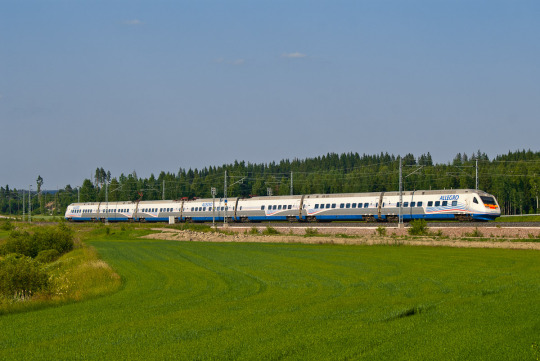
An Sm6 unit on the Kerava-Lahti line, currently the only bit of high-speed rail in Finland, 2011. Teemu Peltonen, Vaunut.org.
Since the 1990s, two daily return trains had been operated between Helsinki and Saint Petersburg, Russia: the Sibelius, which used VR carriages, and the Repin, which used RŽD carriages. In 2006, the two rail operators decided to replace the locomotive-hauled trains, which took five hours to make the trip, with jointly-owned high-speed trains. For this purpose, a new jointly-owned subsidiary Karelian Trains was established.
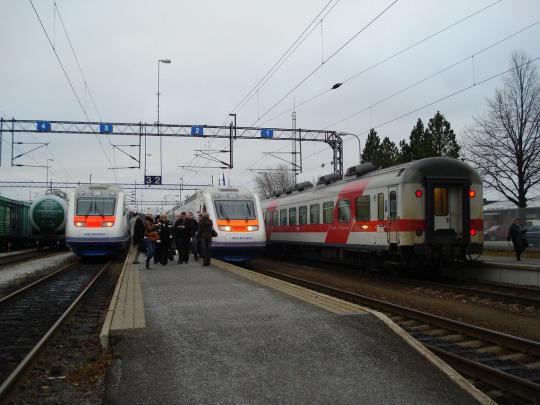
Two Sm6's during pre-service entry test runs at Vainikkala, the border station between Finland and Russia, with the locomotive-hauled St. Petersburg train Sibelius on the right. Lari Nylund, Vaunut.org.
After a round of tenders, Karelian Trains opted for the Pendolino design (already used by VR in the form of the Sm3) from Alstom in 2007, with four units to be delivered in 2010 (there was also an option for two additional units, which was never taken up). Although the exterior design of the new Sm6 units was almost identical to the Sm3, in terms of technology they feature numerous improvements compared to the older class, and were outfitted to operate both on the Russian and Finnish electric systems. Due to the small difference in gauge between the two countries (Russia uses 1520 mm but Finland 1524 mm) the trains were given near-unique gauge of 1522 mm.
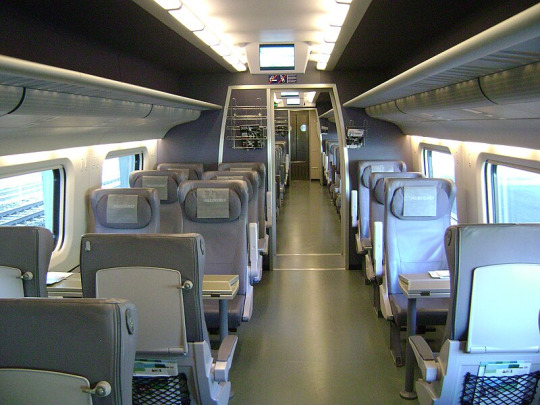
Interior of the Sm6's first-class carriage as delivered. Otto Karikoski, Wikimedia Commons.
Branded Allegro, the new Sm6 units begun operations in December 2010, cutting the travel time between Helsinki and St. Petersburg to 3½ hours. In addition to services offered on Sm3 units, the Sm6 has (or perhaps more accurately had) a space for the border patrol to use, as passport control was done en-route on the train, and a kid's playroom. The original grey-dominated interiors were replaced by new, more colourful blue designs in 2018-2019.
The new interiors were not in use for long before the Covid-19 pandemic caused for passenger train services between Finland and Russia to be suspended in March 2020. The Allegro services were restored in December 2021 (the Helsinki-Moscow sleeper train Tolstoy, however, was not), and ran for less than four months until closed again in March 2022 after Russia's invasion of Ukraine. (VR subsequently stopped freight traffic to Russia too - other Finnish rail operators continue to serve freight to and from Russia, however).
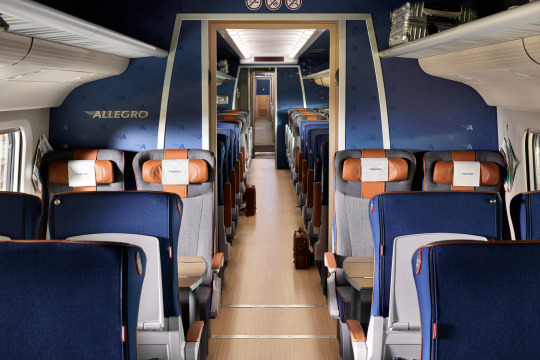
Second-class carriage in the post-2019 look. VR.
After March 2022, the four Sm6 units languished at VR's Ilmala depot in Helsinki, without maintenance as RŽD refused to make any payments for their share in Karelian Trains (which, although jointly Finnish-Russian owned, was registered in Finland). In March 2023, when Finnish prime minister Sanna Marin visited Kiev, Ukrainian Railroads requested the Sm6 units be handed over to them, but nothing ever came of this. Instead, in December 2023, when Karelian Trains was on the brink of bankruptcy due to RŽD not paying their share of the company's bills, VR bought out Karelian Trains and took over the Sm6 units.
The trains will be given a thorough technical refit, which will include removal of the systems to operate with Russian electrification, and will enter services on routes within Finland in 2025. How they will be branded is unknown, though a VR representative said in an interview they will not be called Allegro. Presumably this will make the Sm6 the first VR rolling stock class to be fully painted in the new livery.
43 notes
·
View notes
Photo
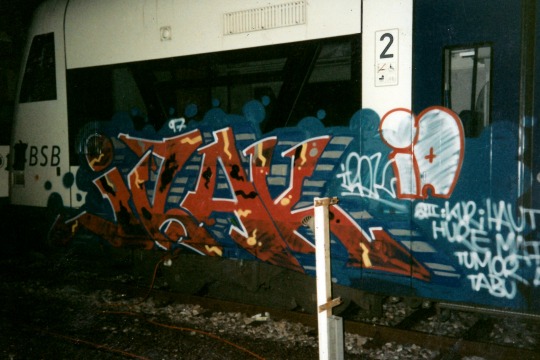
Representative of Freiburg-Style (mid 90s)
#graffiti#freiburg#irak#ia#1997#bsb#regioshuttle#nightshot#trainwriting#traingraffiti#trainbombing#graffiti classics
2 notes
·
View notes
Photo

#photography #fotototal #trainspotting #trainspotter #followmenow #influencer #trainphotography #good #leipzig #instafollow #memories #hbf #instalove #loveit #leipzighbf #erfurterbahn #instafollow #color #leipzighauptbahnhof #followforfollow #regioshuttle #followme #rocknroll #like4likes #beautiful #train #zug #vreizeit #deinelieblingsbahn #elstersaalebahn (hier: Leipzig Hauptbanhof) https://www.instagram.com/p/Cj4pKi3qXeo/?igshid=NGJjMDIxMWI=
#photography#fotototal#trainspotting#trainspotter#followmenow#influencer#trainphotography#good#leipzig#instafollow#memories#hbf#instalove#loveit#leipzighbf#erfurterbahn#color#leipzighauptbahnhof#followforfollow#regioshuttle#followme#rocknroll#like4likes#beautiful#train#zug#vreizeit#deinelieblingsbahn#elstersaalebahn
0 notes
Photo



További képek: http://www.benbe.hu/tagriver.php?sor=&psz=&t1=472&t2=vas%FAtvonal&t3=&num=50&order=one&B1=Mehet
Additional photos of the Tanvald-Harrachov rack railway: http://www.benbe.hu/tagriver_eng.php?sor=&psz=&t1=472&t2=vas%FAtvonal&t3=&num=50&order=one&B1=Mehet
#railway#tanvald#harrachov#czech republic#Czech Railways#zubačka#kořenov#liberec#stadler#regioshuttle#photos#train#ČD
1 note
·
View note
Text
Vlaky RegioSpider vyjely na trať z Postoloprt do České Lípy
Vlaky RegioSpider vyjely na trať z Postoloprt do České Lípy
Na železniční lince U11 Postoloprty – Louny – Česká Lípa nově nasazují České dráhy čtyři motorové vozy řady 841.2 Stadler RegioShuttle RS1. Tyto vozy zakoupil národní dopravce na konci loňského roku od německého dopravce SWEG. Vlaky v budoucnu projdou modernizací. Continue reading

View On WordPress
0 notes
Photo










Samedi 19 mai : Pfingstendampftage au DDM - partie 8
Dernière partie des billets consacrés au festival du musée de Neuenmarkt. Celui-ci est consacré aux navettes effectuées sur le “Schiefe Ebene”, une des rampes les plus célèbres du réseau germanique avec des déclivités atteignant au maximum 25 pour mille.
Les deux premiers allers-retours étaient effectués par la BR 52 8079-7 en solo, mais, surprise, pour le dernier train, la 01 509 s’est invité à la fête, le train comportait donc une locomotive à chaque extrémité de la rame. C’était l’autre évènement de la journée avec la venue de la S 3/6.
Après une section de voie en S, la montée commence en ligne droite, et c’est vraiment impressionnant, encore plus avec deux locomotives qui travaillent dur pour grimper la rampe jusqu’à Marktschorgast ! Même si cela ne dure que quelques minutes, cela reste mémorable, d’autant plus que les paysages environs sont très pittoresques !
Arrivé dans le petit village d’un peu moins de 500 habitants, nous attendons le croisement avec une BR 612 avant de repartir pour le musée... une bien belle façon de conclure la journée.
Je complète ce billet avec une vue d’un Regioshuttle d’agilis, et deux photos au musée !
0 notes
Text

650 539 / VT007 in Basdorf am 24.04.2025
#650 539#Br650#Br 650#VT007#NEB#Niederbarnimer Eisenbahn#NEBB#Niederbarnimer Eisenbahngesellschaft#Barnim#eisenbahn#bahnhof#bahn#triebwagen#brandenburg#dieseltriebwagen#Regioshuttle
9 notes
·
View notes
Video
DLB VT650.77 | Gumpenried-Asbach | 22.06.2017 von Tobias Reisky Über Flickr: Die Strecke von Gotteszell nach Viechtach entland des Schwarzen Regens gehört zu den schönsten in Bayern. Zwischen 1991 und 2016 war hier der reguläre Personenverkehr eingestellt, doch im September 2016 wurde ein sogenannter Probebetrieb eingerichtet, um die Nutzung der Züge zu belegen. Die Strecke hat sich seitdem prächtig entwickelt und weist höhere Fahrgastzahlen auf als viele andere Nebenbahnen, dennoch konnte sich die BEG bislang nicht zu einer dauerhaften Bestellung durchringen. Immerhin soll der Probebetrieb nun um weitere drei Jahre verlängert werden.
#RegioShuttle#Baureihe 650#RS1#Regentalbahn#Länderbahn#Die Länderbahn#Waldbahn#WBA 4#Go-Vit#Viechtach#Gotteszell#Gumpenried-Asbach#Teisnach#Schwarzer Regen#Regental#Bayerischer Wald#Bayerwald#Bayerisch Kanada#Probebetrieb#Reaktivierung#KBS#908#KBS 908
0 notes
Text
Bördebahn
I’ve had some public transit content on my dash today, so I thought it might be interesting to talk about a curious little case study that I tried out yesterday; the RB28 or Bördebahn line.

This line probably sounds terrible at first glance. It connects Düren via Zülpich to Euskirchen, all boring towns you probably never heard of, somewhere in the vast nothingness between Aachen, Cologne and Bonn - and even for those cities it’s debatable how notable any of them are.

The line is a single-track branchline through flat low-density rural areas. It used to be double-track, but the second track is largely overgrown. The halts and stations are all tiny, serving largely inconsequential villages where the station buildings have been boarded up for decades. The train only comes by every two hours, too.
The track and signalling system are largely in bad shape, with lots of speed restrictions. There are about a dozen level crossings where the safety technology doesn’t work, so the driver has to stop the train and wait for all the cars to stop before the train can continue.

All in all, it’s… actually a massive success story.
Everything I’ve described so far is true, but deliberately misleading. The line is on what you could call an upwards spiral. Originally, passenger transport had ended in the 1980s, and the line was left open for the odd freight train only. Around 2001, there were plans to close it down entirely. But a local initiative formed and fought back, organising occasional excursion trains and improving the infrastructure by hand. Over time, politicians noticed this, and started giving money. The excursion trains became regular (every weekend), and integrated into the fares of the overall public transport fare system, which led to lots of normal people using the line for normal trips.
Since 2019, there were six trains per day during weekdays as well. In 2020, trains were increased to one every two hours, and the travel time was reduced to 46 minutes (for 30 km, so still not blazingly fast). Starting this December, trains will run every hour, and even faster. That’s why the train has to stop at several level crossings; they just did a lot of refurbishment work to the line’s electrical systems, and they’re not quite done yet.
And it’s successful. The train I was in is admittedly not a large train (it’s a Stadler RegioShuttle RS1, which seats about 50 people), but it was decently filled. It seems very likely that usage figures will increase a lot once the full hourly service is in place.
Why is that? A part of it seems to be the general idea that if you build it (and run a half-way decent service on it), they actually will come, as the saying goes. If you can organise your day around it, the train is the fastest way to get to either Düren or Euskirchen, and the organising is going to get a lot less.
The other important part is network effects. From Düren you have great connections to Cologne and good connections to Aachen. From Euskirchen, you have connections to Cologne, Bonn and, if you feel like taking a longer journey, Trier. All of the connections are timed well; you’re not rushed, but you don’t have to wait long for your next train either.
In fact, in the regional rail network, the Bördebahn forms something of a missing link. Without it, you have something of a radial network to the south-east of Cologne (Germany’s fourth-largest city): You have great connections to the west to Aachen, to the south-east to Euskirchen and Trier, and to the south to Bonn. But if you want to go from Aachen to Bonn, or Trier, your only choice was to go all the way to Cologne and then back out from there. Now you can just skip that part, thanks to this line (and the Euskirchen-Bonn line that forms a similar tangential connection on that part, but has been around in modern form for longer).
The local transit authority has recognised this potential, and is currently considering electrifying this line by about 2030 and integrating it into another local rail network. That sounds like a great idea, except it would also mean rebuilding all the stations that were just rebuilt due to platform height issues…
The fun part is that this whole story isn’t even particularly unusual for the area. There are two other branch lines from Düren that have been refurbished similarly, just in the 1990s already. They’re also operated by Rurtalbahn, the company that now handles the Bördebahn, and they’ve been great successes. While they stop in small towns in the middle of nowhere and don’t really provide much network effects, they’re still busy and often run at 30 minute intervals.
Further west, another smattering of lines has been reactivated around Aachen under the name “Euregiobahn”, which has some of the most bizarre timetables you’ve ever seen due to an intricate circular network. Further north from that, the branch line to the town of Heinsberg has been reopened. The region is full of such stories of minor lines to minor towns being re-opened since the 1990s, and there are more currently being planned.
What does this tell us in general? Not sure. Probably that you can build attractive train services surprisingly cheaply on abandoned or underused lines, even ones that don’t look particularly attractive. And it also shows the importance of connecting such branch lines with a broader network, to serve as its first and last mile connection.
Progress on all of these things has been slower than you’d like, and some of the progress has actually recently been destroyed in a huge flood (for some of the lines in the Euregiobahn network), but things are definitely improving.
15 notes
·
View notes
Video
youtube
Motororový vůz RegioShuttle v Rychnově nad Kněžnou
0 notes
Text

563 007/107 in Basdorf am 24.04.2025
#563 007#Br563#Br 563#Mireo#Wasserstoff-Mireo#650 539#Br650#Br 650#Regioshuttle#Basdorf#Heidekrautbahn#Niederbarnimer Eisenbahn#Niederbarnimer Eisenbahngesellschaft#Barnim#NEBB#NEB#eisenbahn#bahnhof#bahn#berlin#triebwagen#brandenburg
8 notes
·
View notes
Text

650 539 bei Zernsdorf am 12.02.2022
#650 539#Br650#Br 650#Regioshuttle#NEBB#NEB#Niederbarnimer Eisenbahngesellschaft#Niederbarnimer Eisenbahn#eisenbahn#bahnhof#bahn#berlin#triebwagen#brandenburg#Zernsdorf
11 notes
·
View notes
Text
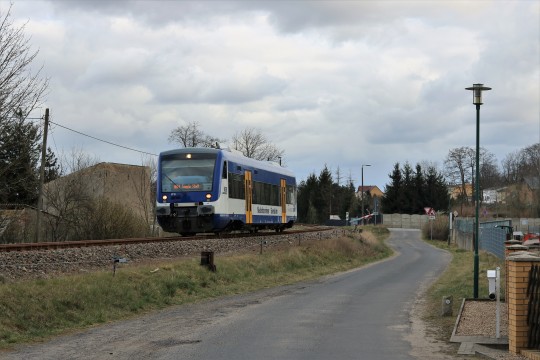
650 542 verlässt Joachimsthal am 02.04.2022
#650 542#NEB VT 010#Br650#Br 650#Regioshuttle#Joachimsthal#eisenbahn#bahnhof#bahn#berlin#triebwagen#brandenburg#dieseltriebwagen#Barnim#Niederbarnimer Eisenbahn#Niederbarnimer Eisenbahngesellschaft#NEB#NEBB
7 notes
·
View notes